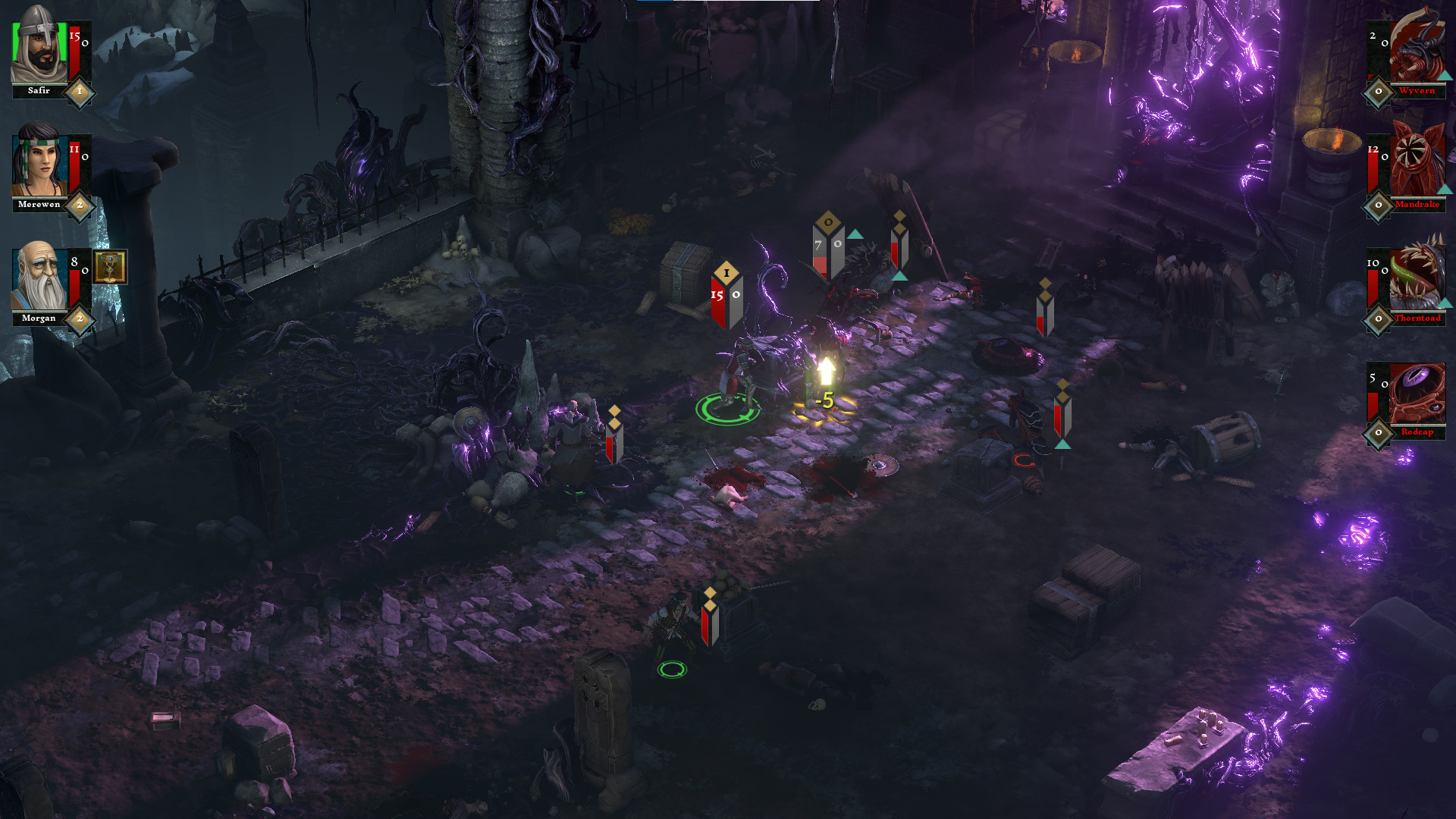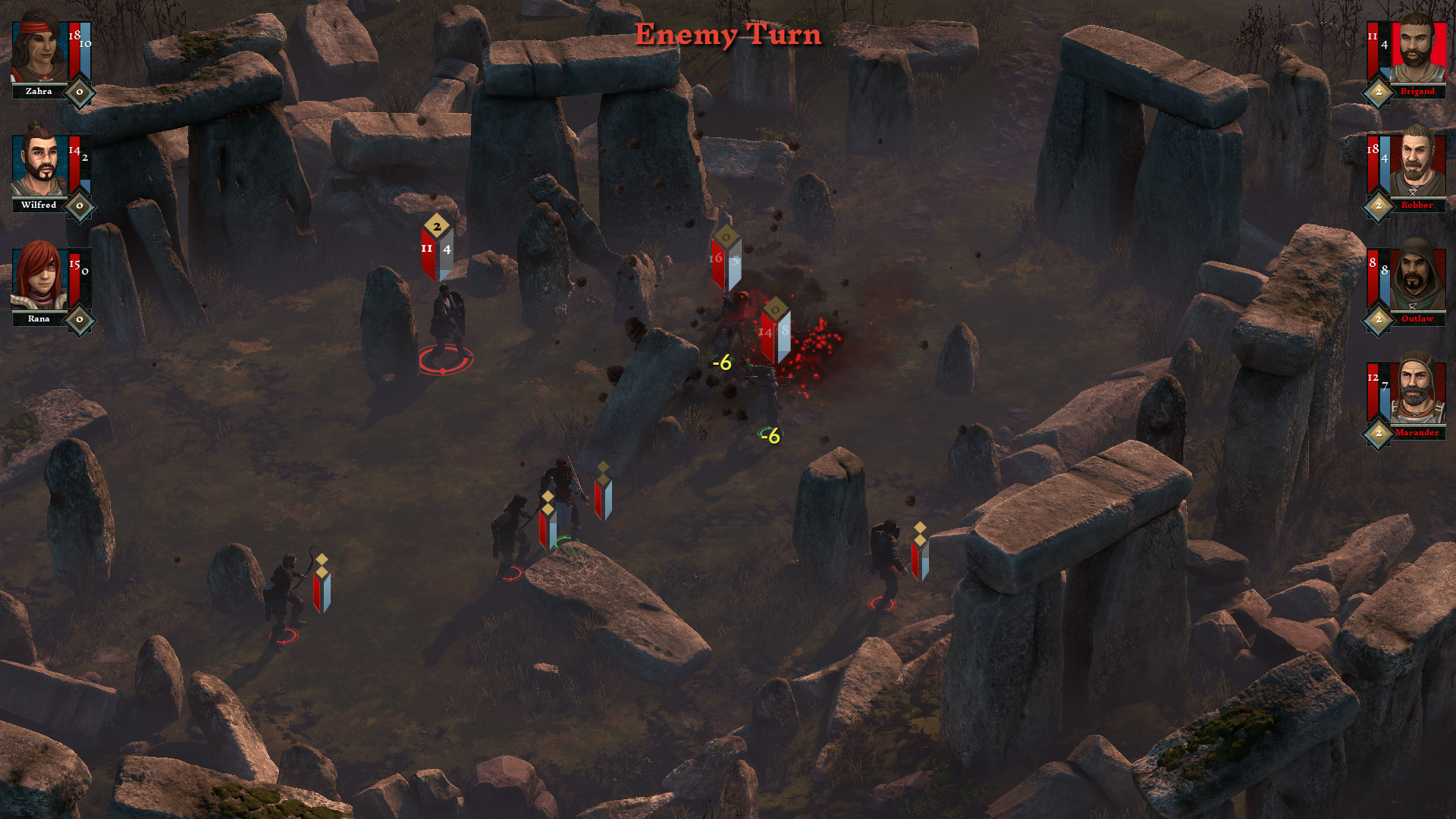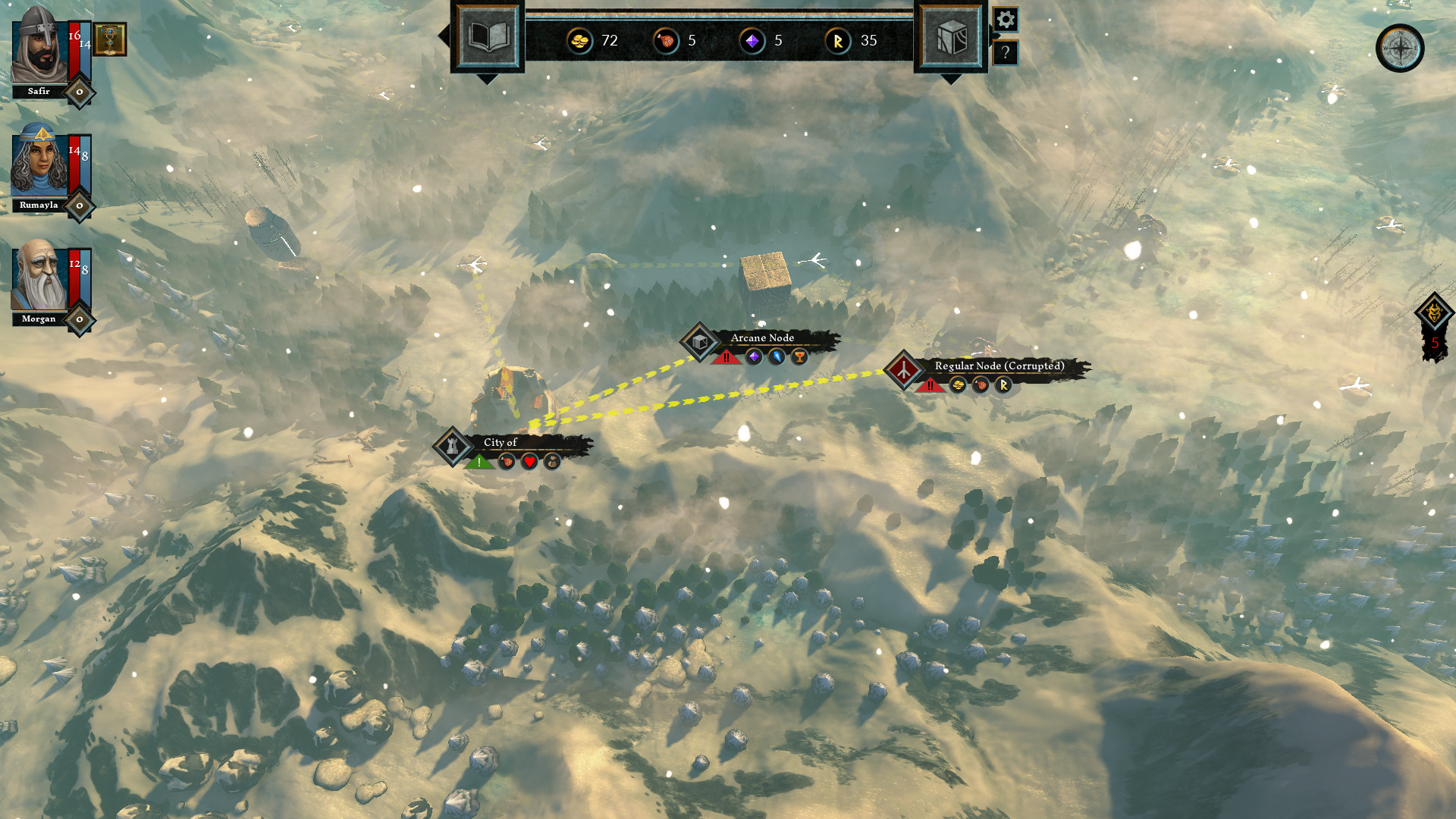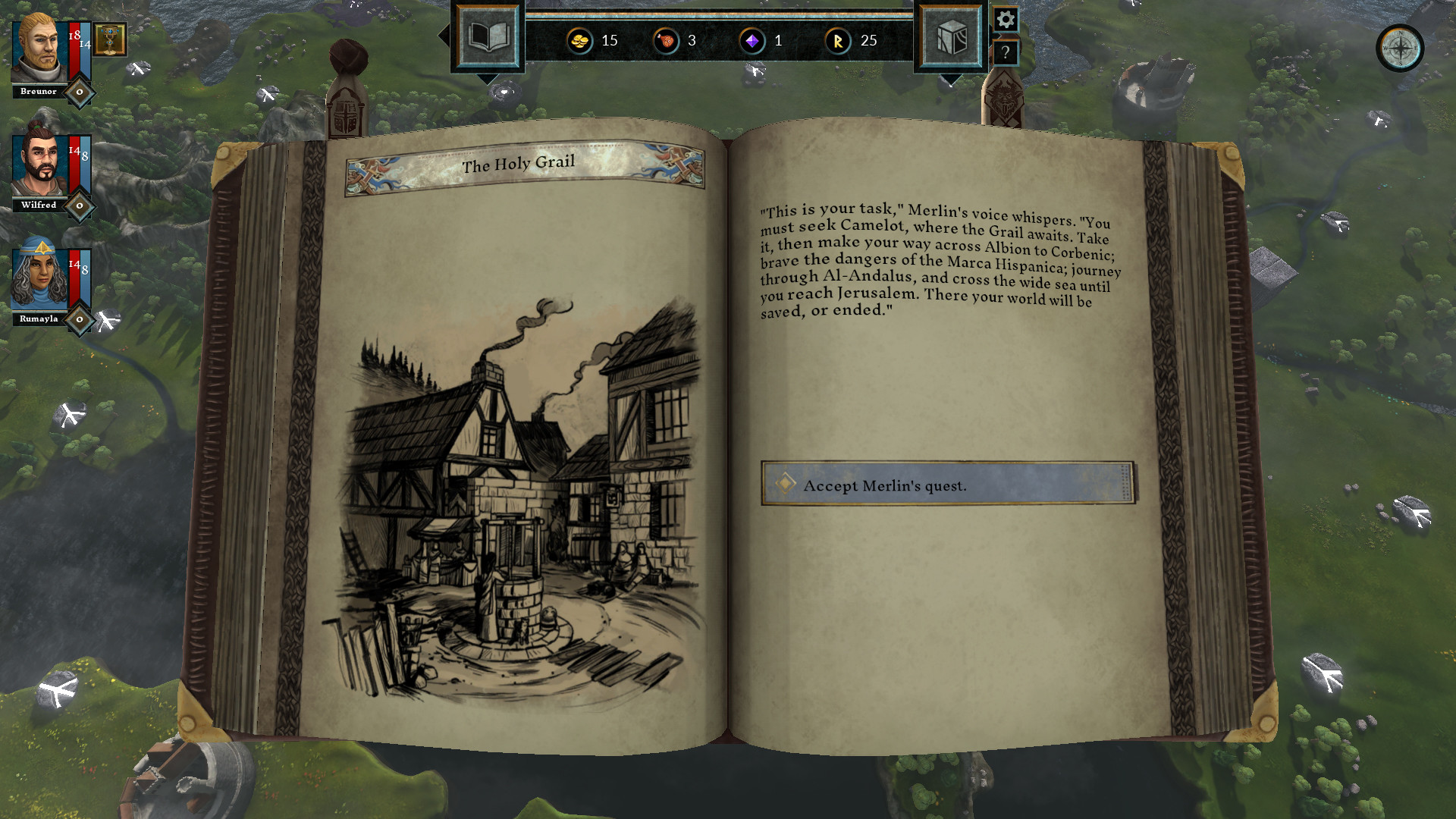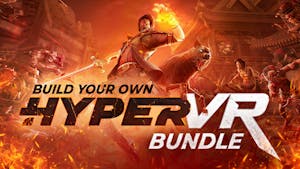
The Hand of Merlin is a turn-based rogue-lite RPG in which Arthurian legend clashes with cosmic horror. Recruit a company of up to three mortal heroes and guide them in spirit on a desperate journey from Albion to Jerusalem. Explore a richly-imagined medieval setting on the brink of apocalypse. Trade with merchants, improve your heroes and unearth ancient relics. Search for the lost fragments of your soul, scattered across the multiverse - and save as many worlds as you can.

Enjoy a compelling story inspired by Arthurian legend, the Matter of France, and the history of Al-Andalus - with an unusual twist. Make choices in interactive encounters that change every time you play. Written by Jonas Kyratzes (The Talos Principle, Serious Sam 4) and Verena Kyratzes (The Lands of Dream, Serious Sam 4).

Master the tactics of squad-based and turn-based combat to conquer both human and demonic foes. Your enemies will be tough and ruthless; make use of cover, set up ambushes and coordinated attacks, harness synergies between different Hero classes and skills.


Carve a path across the lands of Albion, Marca Hispanica and Al-Andalus. Will you take a dangerous route, risking life and limb in pursuit of a legendary relic? Or will you choose a safer path? Plan and prepare. Negotiate, barter, fight. Tackle challenges. Suffer losses. Recruit new Heroes. Earn Gold, Supplies and Renown. Be careful: your choices are permanent, as is death. But don't tarry - evil never rests.

Use Renown to level up your Heroes, and choose between a randomized set of new skills or improved attributes. But choose wisely! Select skills with great synergy and balance your party for the road ahead.


As you jump from one parallel dimension to the next, history is reshaped. Different kings rule the land, changing the encounters, characters, and events. No two worlds are ever quite the same, and each journey will be unique. And should your heroes fall, remember: defeat is not the end, only a new beginning.

Seek out towns to improve your arms and armor, or stumble upon hermit artisans in the wild. With every day that passes, the world plunges deeper into darkness, and you will need all the equipment gold can buy.

From a peasant's humble luck charm to the legendary sword wielded by Arthur himself, items imbued with magical power are scattered about the world. Some you will be able to purchase from merchants and collectors, but others will have to be earned through acts of heroism - or displays of wit.

Rain thunder and brimstone upon your foes! Seek out and gather Soulstones to restore your power and unlock new Spells. Even if defeated, your spirit will retain all of your collected arcane knowledge as you jump into the next dimension.
There are as many worlds as there are stars in the sky. In each stands Camelot; in each there is a Grail. But there is only one Merlin, and his eternal burden is to stand against the horror from beyond. Each world that is saved is saved forever; each world that is lost is lost for good.
https://store.steampowered.com/app/600610/The_Hand_of_Merlin/
This post is written by Mat, our gameplay designer.
Hello again! Glad to be able to sneak you all another peek of our design tables. Today, I want to talk a bit about how the Skill Overhaul went, and a bit more about what we found out, and how we are planning to move forward.
In The Hand of Merlin, the primary operand you have in tactical play is your characters abilities. They define what actions you possess, and drive your strategy. Especially since we wanted to make the game straightforward, without many auxiliary mechanics (such as Zone of Control, Facing), getting abilities right is paramount to our success. Ill talk more about that decision, but first, let me remind you what the Skill Overhaul was.
When we developed the player abilities, we approached it with three design pillars in mind: Niche Protection, Thematic Flavour, and Problem Solving. That is to say, an ability had to (a) feel like their class, (b) evoke a specific fantasy associated with our cultural touchstones of that class, and (c) serve a specific need in the map. For instance, consider Hunters Mark - your ranger is a trained hunter, able to focus on specific enemies to give extra damage. It ticked all the boxes, surely: Its a damage buff that only works for the main damage-dealer, it feels very flavourful, and it could help out by bringing down bigger enemies, like Behemoths of Lindworms.
Then, we doubled down on themes for the upgrades - Hunters can boast about their kills! turned into Hunters Prize, for instance. And, you know, it all made sense and made the abilities work.
If this was closer to a traditional C/JRPG (Baldurs Gate, Final Fantasy) this couldve been enough, but there was a key aspect that slipped a bit: The Cost of a Slot.
In those games, you can amass great quantities of skills to use. Even if you dont use them a lot, there might eventually be some specific conditions where the ability would come into place, but in The Hand of Merlin, picking something like Staggering Blow meant that of all of your main actions are dedicated to the problems that Staggering Blow can solve. In those cases, why would you pick something conditional over a direct, reliable damage increase?
The data was clear - Quick Draw, Cleave, Concoction, all damage-dealing abilities were far more reliable and attractive. So, we had to make some adjustments.
We added the No Roadblock Design and the Slot Worth pillar. I talked a bit more about the first aspect in previous posts, but the second one is quite simple: at the end of the day, abilities are compared in regards to their capacity to provide the opportunity to deal/negate damage, which is the actual end objective and what makes you choose one over the other for your few slots. Debuffs became more violent or simply easier to use, and we discovered some success in adding action points or cooldown reduction to emphasize that even further.
With the changes made, we went on to play with it! We do a lot of internal playtesting, having a few very competent players in our dev team. They play a few runs, try to break things, and relate their feelings about specific abilities/strategies over to us in Design. It seems like the game was more varied, had less obvious winning strategies, and felt more fun overall. Some of our community feedback seemed to agree, and we were having a much better time.
But we are not done! While pursuing the need to have a small set of 4 abilities to be very versatile and powerful and keeping our current systems, we had to employ a combo-building approach, common to some deckbuilding games. It seems that the game switched a bit more towards trying to create powerful game-breaking builds (10 AP actions! Instant CD reduction! Kill Behemoths by bypassing armor!), as we oriented design towards multiplicative effects, power-scaling, and similar drives. Its fun, engaging, and far better than to be bothered by upgrades you didnt want, but theres still something to solve: Cheese.
We call Cheese strategies that are made available by combining separate mechanics in ways that we did not predict, creating an effect so powerful that the enemies cannot keep up with, effectively solving the game. The old version still had these (Kaz, one of our artists, could win the 3rd boss fight in a single turn), but the current model still has quite a few. A marked power creep and the capacity to bypass several systematic difficulties like cooldowns made the game a bit easier and a bit, well, out of control. Hallow + Warcry on Salim with Quick-shot and Take Aim/Far Shot comes to mind.
Still, we consider it to be a fun take on the genre, and it fulfills our vision for a tactics game that is status effect and ability-driven, with many ways to create complex builds and strategies, so I dont expect a lot of systematic changes apart from those we introduce with meta progression.
What do we want to do now? First, we will normalize the peaks and valleys, such as making cooldown matter a bit more or making the Grail relics a bit more engaging. Then, we will make sure that the enemies gain some cool toys to play with too: More complex abilities and combo potential, but also the new enemies we have planned.
In the end, were excited to see how the game is changing and improving based on your feedback, but we are not done yet! We want to make sure our players have decent challenges to face and can have as many meaningful choices as possible. With some effort and more feedback from you, well get there soon!
Thanks for reading and playing!
Join our Discord server!
Mat
Minimum Setup
- OS: Linux SteamOS 3.0 or Ubuntu 18.04 LTS
Recommended Setup
- OS: Linux SteamOS 3.0 or Ubuntu 18.04 LTS
[ 6505 ]
[ 4514 ]
[ 5360 ]

